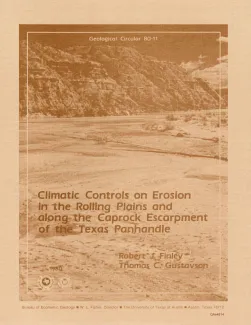
Publication Details
Geolocation:
Get the Publication
$10.00
Abstract/Description:
The climate of the Texas Panhandle is primarily semiarid continental, exhibiting a pronounced peak in precipitation during the months of May through July. Storm data from a 22-county study area show a pattern of heavy, localized rainfall with high (1 to 5 inches/h or 25 to 127 mm/h) rainfall intensities for periods of 5 to 60 minutes. These characteristics are typical of the thunderstorm rainfall of the area. Depth-frequency relationships show mean 24-hour rainfall totals of 2.55 inches (65 mm), 4.25 inches (108 mm), and 5.07 inches (129 mm) for 2-, lo-, and 25-year return periods, respectively. As a result of intense thunderstorm rainfall activity in a predominantly grassland environment, rainsplash, sheetwash, and rillwash are significant processes of surface erosion. The low degree of induration of many Permian shales, siltstones, and sandstones also increases their erodibility within the Rolling Plains area. Thin soils characteristic of 6' to 24' slopes have only poor to fair capability to support grasses and shrubs; hence, vegetation has little mitigating effect on active erosional processes, especially along the Caprock Escarpment. Erosion pins at surface-process monitoring localities show 0.04 to 0.08 inch (1 to 2 mm) of erosion for a single typical thunderstorm and up to 2.4 inches (6.2 cm) of erosion for a 10-year return period storm. Greatest net erosion has been observed on slopes of 20' or greater with 10 percent or less vegetative cover. Erosion mechanisms are applicable only under the present interglacial climatic regime, which has probably prevailed for the past 8,000 years.